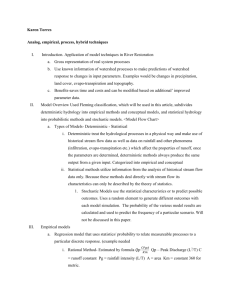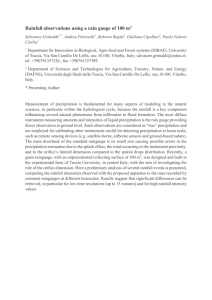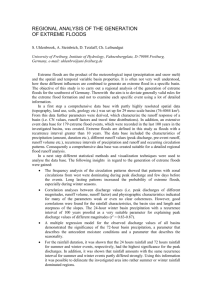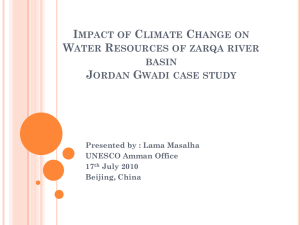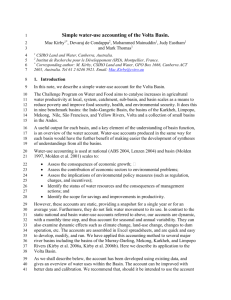Journal of River Basin Management
advertisement
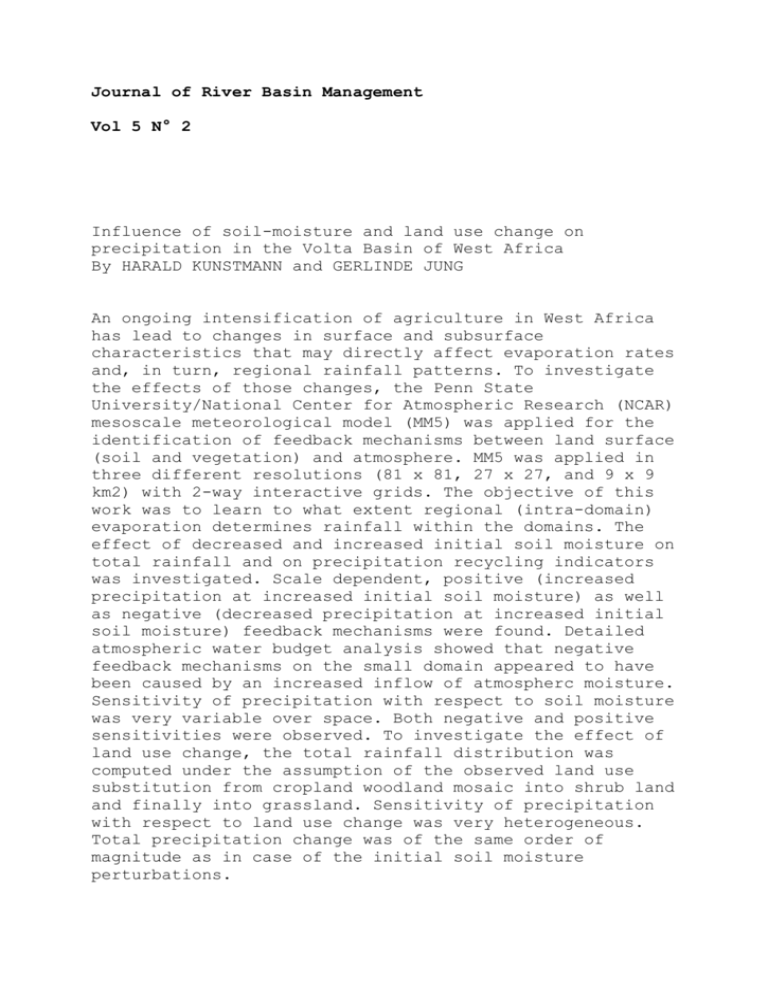
Journal of River Basin Management Vol 5 N° 2 Influence of soil-moisture and land use change on precipitation in the Volta Basin of West Africa By HARALD KUNSTMANN and GERLINDE JUNG An ongoing intensification of agriculture in West Africa has lead to changes in surface and subsurface characteristics that may directly affect evaporation rates and, in turn, regional rainfall patterns. To investigate the effects of those changes, the Penn State University/National Center for Atmospheric Research (NCAR) mesoscale meteorological model (MM5) was applied for the identification of feedback mechanisms between land surface (soil and vegetation) and atmosphere. MM5 was applied in three different resolutions (81 x 81, 27 x 27, and 9 x 9 km2) with 2-way interactive grids. The objective of this work was to learn to what extent regional (intra-domain) evaporation determines rainfall within the domains. The effect of decreased and increased initial soil moisture on total rainfall and on precipitation recycling indicators was investigated. Scale dependent, positive (increased precipitation at increased initial soil moisture) as well as negative (decreased precipitation at increased initial soil moisture) feedback mechanisms were found. Detailed atmospheric water budget analysis showed that negative feedback mechanisms on the small domain appeared to have been caused by an increased inflow of atmospherc moisture. Sensitivity of precipitation with respect to soil moisture was very variable over space. Both negative and positive sensitivities were observed. To investigate the effect of land use change, the total rainfall distribution was computed under the assumption of the observed land use substitution from cropland woodland mosaic into shrub land and finally into grassland. Sensitivity of precipitation with respect to land use change was very heterogeneous. Total precipitation change was of the same order of magnitude as in case of the initial soil moisture perturbations. Climate trends of temperature, precipitation and river discharge in the Volta Basin of West Africa By REBEKKA NEUMANN, GERLINDE JUNG, PATRICK LAUX and HARALD KUNSTMANN The impact of climate change on precipitation and water availability is of major concern for policy makers in the Volta Basin of West Africa, whose economy mainly depends on rainfed agriculture and hydropower generation. It is therefore essential to know if, and to which extent climate trends in the Volta Basin exist that impact water availability. In this study, the present trends in precipitation, temperature, and river discharge for the Volta Basin were analysed. Linear trend and corresponding levels of significance were calculated for time series of annual and monthly maxima and corresponding means respectively. Trends of total annual precipitation and standard deviations for all considered variables were analysed. In addition, the stability of linear trends was considered via reverse arrangement test. Clear positive trends with high levels of significance were found for temperature time series. Precipitation time series showed both positive and negative trends, whereas most significant trends were negative. However, due to the small number of significant cases, only weak trends towards a decrease in precipitation can be concluded. Most of the significant trends of the standard deviation in precipitation were negative. Due to this observation a trend towards a decrease in the variability of precipitation is concluded. In case of discharge time series, a small amount of (predominantly positive) significant trends for the wet season was observed. The majority of the significant trends for the dry season were negative. For discharge no clear trend could be evaluated though, as the anthropogenic influences (e.g. building of dams, intensified irrigation) could not be quantified. Both, standard deviation of temperature and of river discharge show positive and negative significant trends. Thus one can not draw the conclusion of a change in temperature and river discharge variability. It is additionally shown that monthly precipitation trends can be weakly linked to climate indices. This was achieved by linear correlation analysis between monthly precipitation amounts and the climate indices NAO, SOI, TNA, TSA Demand and supply of improved water in the Ghanaian Volta Basin By STEFANIE ENGEL, MARIA ISKANDARANI and MARIA DEL PILAR USECHE Growing efforts are undertaken at the local, national, and international level to improve water supply in developing countries and thereby help people to satisfy their basic water needs. This study aims at an evaluation of households' actual access to and use of improved water sources in rural communities in the Ghanaian Volta basin. A statistical analysis of a household survey conducted in the Volta Basin helps to demonstrate that access to improved water does not automatically translate into use of it for all households. Our analysis shows that 43 per cent of those households that had access to an improved source still use unsafe water as their main domestic water source. Relative distance to improved and unimproved sources, the pricing system established locally, and quality perceptions all are likely to influence household water source choices. Water and electricity sector reforms in Ghana: Back on track? By SUSANNAWOLF, VERONIKA FUEST and FELIX ASANTE The lack of continuous and reliable supply of energy and water is a major hindrance to industrial and agricultural productivity in Ghana. Similar to the public utility management problems found in most developing countries, the electrical and water utility companies of Ghana have suffered from a number of institutional and operational shortcomings, including low collection rates, high wastage, operational losses, and inadequate staffs. Reforms of the energy and water sectors have been under way since the beginning of the nineties. Prices have increased significantly, but there has been little or no improvement in services. This analysis will focus on ongoing reforms, their likely effects on different user groups and the obstacles for their implementation. Those who provided water and electricity were plagued with institutional weaknesses, and regulating agencies did not perform according to their mandates. The regulating agencies were lacking financial and human resources for monitoring, and their functioning suffered from principal agent problems. The government policy of private sector participation in utility provision has been only partially implemented for various reasons: the providers of water and electricity and the government agents that manage the reform process have a greater effect on manufacturers than they do on agriculture because the former have the greater need for regular supplies of water and electricity. The potentials and interest of the clients, regulating agencies and providers as well as the relationships between them have to become a key issue in the reform process. There is a need for more transparency and accountability on the part of politicians and providing agencies - whether public or private, local or national. Hydrological parameterization through remote sensing in Volta Basin, West Africa By MOHSIN HAFEEZ, MARC ANDREINI, JENS LIEBE, JAN FRIESEN, ANDREAS MARX and NICK VAN DE GIESEN Ground-based hydrological data collection tends to be difficult and costly, especially in developing countries such as Ghana and Burkina Faso where the infrastructure for scientific monitoring is limited. Remote sensing has the potential to fill the gaps in observation networks. The GLOWA Volta Project (GVP) seeks to maximize the information to be gained from satellite imagery by combining remotely sensed data with strategically chosen ground observations. However, there is very limited information about the coupling of remotely sensed data with ground based data over the mixed savanna terrain of West Africa. This paper provides an overview of innovative techniques to measure hydrological parameters as actual evapotranspiration, rainfall, and surface runoff over mixed savanna terrain in a semi-arid region in West Africa, and their potential use. Evapotranspiration - The Surface Energy Balance Algorithm for Land (SEBAL) was used to calculate sensible heat flux and evapotranspiration through the energy balance. The SEBAL parameterization is an iterative and feedback-based numerical procedure that deduces the radiation, heat and evaporation fluxes. Along a 1,000 km gradient in the Volta Basin, three scintillometers were installed to measure sensible heat flux over distances comparable to NOAA-AVHRR pixels, approximately two kilometers. The comparison of sensible heat flux measured from remotely sensed data and scintillometers provide accurate results. This will help to increase the reliability of SEBAL parameterization. Rainfall - Depending on the region within the Volta Basin, up to 90% of the precipitation in originates from squalllines. The Tropical Rainfall Measuring Mission (TRMM) imagery provides a valuable tool to monitor such squall lines. However, the TRMM signal should be validated for squall line rainfall. To increase the reliability of space-based rainfall measurements, TRMM based rainfall rate estimates were calibrated with rainfall measurements from a dense network of rain gauges. Surface Runoff Remote sensing has limited value in estimating surface runoff. The savanna of West Africa, however, is dotted with a large number of small reservoirs used to supply water for households, cattle, and small scale irrigation. Bathymetry of sixty reservoirs in Ghana's Upper-East Region produced a very regular correlation between surface area, as observable by satellites, and volumes. By using all-weather RADAR imagery and the measured surface/volume curves, surface runoff volumes can be monitored throughout the year. These indirect runoff measurements will help researchers to develop surface-runoff models for the Volta Basin. A hybrid metric-conceptual (HMC) model for monthly riverflow prediction in the semi-arid Volta Basin of West Africa By B.A. AMISIGO and NICK VAN DE GIESEN BUY IT or login to download the full paper Data-based mechanistic modelling techniques have been applied to catchment monthly runoff, potential evaporation and rainfall time series to model monthly catchment runoff at selected gauging sites in the Volta Basin of West Africa. The aim of the study was to obtain a modelling framework that not only accounts for the rainfall-runoff non-linearity in the basin and provides acceptable predictions of the monthly catchment runoff for the subbasins studied, but also reveals the necessary insights for a plausible interpretation of the rainfall-runoff mechanism in the basin. The rainfall-runoff process was considered in two stages - a nonlinear transformation from rainfall to effective rainfall and then a linear transformation from effective rainfall to runoff. First a linear time varying, state dependent parameter (LTV-SDP) transfer function model was applied to the monthly rainfall-runoff calibration series of each sub-basin to determine the form of the rainfall-effective rainfall nonlinear transformation. The observed series (runoff or rainfall) that was significantly related to effective rainfall was then identified. Next, the functional form of this relationship was established and used to fit linear time invariant (LTI) transfer function models relating monthly runoff to monthly effective rainfall and potential evaporation. The best estimate of the monthly effective rainfall from the nonlinear modelling was obtained from the product of monthly rainfall and a fractional power of monthly runoff - the runoff acting as surrogate for catchment wetness. Since this form of effective rainfall cannot be used for simulation in validation mode (as the runoff series is unknown then), a non-linear rainfall filter used in the Identification of unit Hydrographs And Component flows from Rainfall, Evaporation and Streamflow data (IHACRES) application was used to model effective rainfall in this mode. The study showed that monthly catchment runoff in the basin can be decomposed into two parallel flows, an instantaneous (within a month) and a slower (with one month delay) flow components. These results suggest that baseflow contribution to streamflow is insignificant in the Volta Basin.

